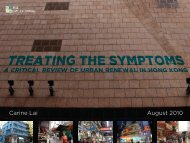Untitled - Civic Exchange
Untitled - Civic Exchange
Untitled - Civic Exchange
You also want an ePaper? Increase the reach of your titles
YUMPU automatically turns print PDFs into web optimized ePapers that Google loves.
SUSTAINABLE TRANSPORT IN HONG KONG: DIRECTIONS AND OPPORTUNITIES<br />
Plan for people, not vehicles<br />
The Rio Declaration on Environment and Development reminds us that:<br />
"Human beings are the centre of concerns for sustainable development. They are entitled to a<br />
healthy and productive life in harmony with nature." 24<br />
Sustainable transport cannot be realized if policy-makers focus on facilitating vehicles rather than people.<br />
Lowe called for "...putting [the] automobile back into its useful place as a servant. With a shift in priorities,<br />
cars can be part of a broad, balanced system in which public transport, cycling and walking are all viable<br />
options." 25 Vuchic proposed that transport systems should facilitate urban livability. A livable city is<br />
human-centered, environmentally friendly, economically viable, socially sound and "connotes a desirable<br />
quality of life for its citizens - including social activities, attractive public places, provision of a certain<br />
level of privacy, as well as a sense of community." 26<br />
1.3 A paradigm for assessing sustainable transport options<br />
Figure 1.1 shows the paradigm developed as part of this study to assess the different options available for<br />
making Hong Kong's transport system more sustainable. We have chosen to show mobility as the<br />
primary objective of sustainable transport, rather than environmental or social goals. Environmental<br />
and social considerations are undoubtedly important, but are most appropriately considered as part of the<br />
larger context that shapes efforts to meet the primary objective of mobility. The primary aim of transport<br />
planning, especially from the perspective of most transport planners, is mobility and we feel that any vision<br />
of a more sustainable transport system for Hong Kong must acknowledge this explicitly. From the<br />
consumer's standpoint, prioritizing mobility means that travel times are reasonably predictable and that the<br />
preferred mode is reliable, convenient, comfortable, and safe, while still being priced within the means of<br />
most people.<br />
A second important aspect of Figure 1.1 is the relationship between planning- and technology-based<br />
solutions. All too often, the focus in transport has been on technological fixes - either some new<br />
technology 27 or better utilization of existing technologies (e.g., additional roads) - that will allow us to<br />
continue doing things very much as we do them today, but with somewhat less damage to the environment,<br />
or temporarily circumvent other problems, such as road congestion.<br />
10<br />
24 UNCED (1992), Report of The United Nations Conference on Environment and Development, Annex 1, Rio<br />
Declaration on Environment and Development.<br />
25 Lowe, M. (1990), Alternatives to the Automobile: Transport for Livable Cities, Worldwatch Paper No. 98,<br />
Worldwatch Institute.<br />
26 Vuchic advocates that a transport system for a livable city must (i) provide service to all areas where there is a<br />
need for transportation; (ii) be available to all groups of people; (iii) provide local access to long-distance terminals;<br />
(iv) satisfy travel volume requirements; (v) have satisfactory performance (for example, speed, safety, reliability,<br />
comfort); (vi) involve reasonable costs and be properly priced; (vii) provide for efficient movement of goods and<br />
deliveries throughout urban areas; (viii) provide facilities and services that are efficiently incorporated with a<br />
human-oriented urban environment; (ix) stimulate creation of desirable urban development and forms; and (x) have<br />
low negative side effects. Vuchic, V. R. (1999), Transportation for Livable Cities, New Brunswick, NJ: Center for<br />
Urban Policy Research, The State University of New Jersey, Rutgers, pp.233, 234.<br />
27<br />
High expectations regarding electric battery vehicles since at least the 1970s are one example of the optimistic<br />
view that technological breakthroughs will provide a technical fix for transport problems. Hopefully, the optimism<br />
of the 1990s and early 21 st century regarding fuel cells will be validated or expectations will at least be brought into<br />
line with actual (rather than hoped-for) breakthroughs.

















